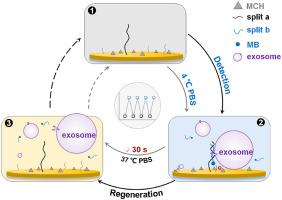Analytica Chimica Acta ( IF 5.7 ) Pub Date : 2022-06-02 , DOI: 10.1016/j.aca.2022.340027 Dongfang Liu 1 , Jinlu Tang 2 , Hui Xu 1 , Kun Yuan 1 , Aaron Albert Aryee 1 , Cuijie Zhang 1 , Hongmin Meng 1 , Lingbo Qu 3 , Zhaohui Li 3

|
In this paper, a split-aptamer mediated regenerable temperature-sensitive (SMRT) electrochemical biosensor was constructed for the detection of exosomes. The split-aptamer used in this SMRT biosensor was composed of two fragments, one of which was immobilized on the surface of an electrode via sulfhydryl groups and named split-a and the other was labelled with methylene blue and named split-b. The two fragments could form sandwich structures at the electrode surface via target-induced self-assembly in the presence of target exosomes at 4 °C in PBS, and then realizing the detection of exosomes via voltammetry. In addition, due to the temperature sensitivity of the split-aptamer, the electrode could be regenerated through temperature-induced disassembly of the sandwich structures. Consequently, the SMRT biosensor realized sensitive and specific analysis of target exosomes with a limit of detection of 1.5 × 106 particles/mL and could be quickly and easily regenerated by washing with PBS at 37 °C for 30 s without any additives. This is the first study on the construction of a reproducible electrochemical biosensor using a split-aptamer for the specific detection of tumour exosomes, and may provide an innovative strategy for the economical and efficient design of regenerable electrochemical biosensors.
中文翻译:

用于检测肿瘤外泌体的分裂适体介导的可再生温度敏感电化学生物传感器
在本文中,一个s plit -aptamer介导的可再生t构建了用于检测外泌体的温度敏感(SMRT)电化学生物传感器。该SMRT生物传感器中使用的分裂适体由两个片段组成,一个片段通过巯基固定在电极表面,命名为split-a,另一个用亚甲蓝标记,命名为split-b。这两个片段可以在 4 ℃ PBS 中在目标外泌体存在下通过目标诱导自组装在电极表面形成三明治结构,然后通过伏安法实现外泌体的检测。此外,由于分裂适体的温度敏感性,电极可以通过夹层结构的温度诱导分解来再生。最后,6 个颗粒/mL,可以通过在 37 °C 下用 PBS 洗涤 30 s 快速轻松地再生,无需任何添加剂。这是第一项利用分裂适体构建可重现的电化学生物传感器用于特异性检测肿瘤外泌体的研究,可能为经济高效地设计可再生电化学生物传感器提供创新策略。









































 京公网安备 11010802027423号
京公网安备 11010802027423号